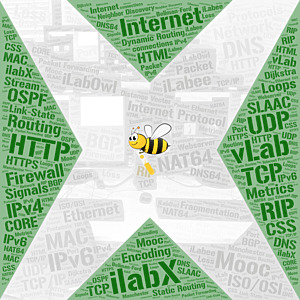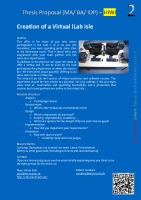iLabX - The Internet Masterclass
Running NOW on edX!
The course runs from June 24, 2019 until February 24, 2020. It is self-paced, so you can define yourself when and where to learn. You should plan between 4-6h for each of our six units.
>>> To the free public edX course page!
To the TUM-internal course "iLab X - The Virtual Internet Laboratory"
Short Trailer
More Info
We have many resources about the iLabs and this course. Check them out, like them, share them!
Director's Cut Trailer
Mailing list
If you want to be informed about the course, write us an email to ilabx AT ilabxp DOT com.
About
The Internet has become one of our most important infrastructures. It connects everything, from people to machines, in all areas, from the art world to the stock exchange, everywhere on this planet and beyond. But how does this Internet that enables so many things in our daily lives actually work? After taking part in iLabX, you will not only understand the mechanisms behind the Internet, but you will create the Internet yourself on your own computer!
iLabX uses an award-winning methodology to teach you how the Internet works. Starting with the physical cables, you will learn, in six parts: what exactly happens when you open a website in your browser, or send a chat message to a friend, how to setup a webserver yourself, how the ongoing transition between the “old” Internet version and its current successor can be so seamless, and key security concepts.
Each module first introduces the background of the relevant mechanisms and tools. After learning the concepts through videos, texts, and diverse interactive learning elements, you will build your own fully-functional Internet. Within our special vLab virtual Internet laboratory, you will use the same tools that also power the big Internet. Under our close guidance, each module brings you closer to having a fully-functional Internet running on your computer. As we use the real Internet mechanisms, we will even connect your creation to the real Internet at the end. Consequently, you can call yourself a true Internet master after completing this course!
When designing this course, we focused on making it exciting and continuously motivating for you. No matter what kind of learner you are, you will find the right learning experience! Our videos explain everything in detail. If you prefer reading instead, go ahead. You can read the texts instead of or in addition to the videos. We have many practical exercises and of course the virtual laboratory that allows you to configure the real Internet on your computer! Last but not least, we have an engaging story that continues through all parts: Help the iLabees scale their honey sales up, taking their business to the summit of the Internet mountains!
What you'll learn
- A full understanding of how the Internet works in its current versions IPv6 and IPv4
- Basic knowledge about the Layered Architecture of the Internet
- Applied understanding of common Internet Protocols
- Applied understanding of common Internet Applications including DNS, NAT, and firewalls
- Applied understanding of Internet security challenges and mitigation mechanisms
Detailed Keywords for the six Parts of the Course
- Part 1 - Signals and Cables: Signals, shared medium, physical medium, noise, addressing, topologies, unicast, broadcast, headers, payload, trailer, twisted pair, optical fiber, wireless, non-return to zero (NRZ), Manchester encoding, self-clocking.
- Part 2 - Internet Protocol: Internet Protocol (IP), IPv6, IPv4, subnetting, fragmentation, Stateless Address Auto Configuration (SLAAC), Neighbour Discovery Protocol (NDP), Internet Control Message Protocol (ICMP), static routing, forwarding, multicast.
- Part 3 - Routing: Dynamic routing, longest prefix matching, Autonomous System (AS), Open Shortest Path First (OSPF), Routing Information Protocol (RIP), Dijkstra, Bellmann-Ford, paths, loops.
- Part 4 - Transmission Control Protocol and User Datagram Protocol: Transmission Control Protocol (TCP), User Datagram Protocol (UDP), reliable communication, stateful communication, 3-way handshake, aknowledgements (ACK), piggyback, retransmission, congestion control, flow control.
- Part 5 - Domain Name System and Webservers: Domain Name System (DNS), resolver, nameserver, zones, sub-domains, iterative vs. recursive name resolution, A and AAAA records, Hyper Text Transfer Protocol (HTTP), Transport Layer Security (TLS), HTTPS, virtual hosts.
- Part 6 - DNS64/ NAT64 and Firewalls: Network Address Translation (NAT), DNS64, NAT64, state, address rewriting, IP 5-tuple, chains, filter, blacklisting, whitelisting, rules, firewall, tables.

Interview with Vint Cerf on why the MOOC matters¶
At the occasion of the Heidelberg Laureate Forum, I had the chance to interview Vint Cerf. Together with Bob Kahn, Vint designed the internet in the early 1970s. In the interview we talk about why understanding the basics of the Internet matters.
Team¶
For the creation of the MOOC I built a great team consisting of:
 Marc-Oliver Pahl (lead)
Marc-Oliver Pahl (lead) Stefan Liebald (course development)
Stefan Liebald (course development) Christian Lübben (videos, testing)
Christian Lübben (videos, testing) Lars Wüstrich (course development, vLab)
Lars Wüstrich (course development, vLab) Jonas Andre (testing)
Jonas Andre (testing) Cedric Mohler (videos, bee story implementation)
Cedric Mohler (videos, bee story implementation) Moritz Sichert (virtual lab environment)
Moritz Sichert (virtual lab environment) Lucas Wolf (course development, vLab)
Lucas Wolf (course development, vLab) Donika Mirdita (course development)
Donika Mirdita (course development) Kirill Kldiashvili (course development)
Kirill Kldiashvili (course development) Edwin Cordeiro (initial development)
Edwin Cordeiro (initial development)
Info about the iLabs¶
The iLabs are a very successful teaching series about distributed systems and networking. Together, the iLabs reached far more than 2000 students between 2004 and 2018. The iLabs currently consist of five courses:
- iLab - Build your own Internet (since 2004),
- iLab2 - You set the Focus! (since 2010), and
- iLabX - The virtual Internet Laboratory (since 2018) are lab courses that I designed that run very successfully with more than 2000 participants at different German Universities.
- iLabS - Secure Internet Measurements (since 2018),
- iLabX - The Internet Masterclass (since 2019).
